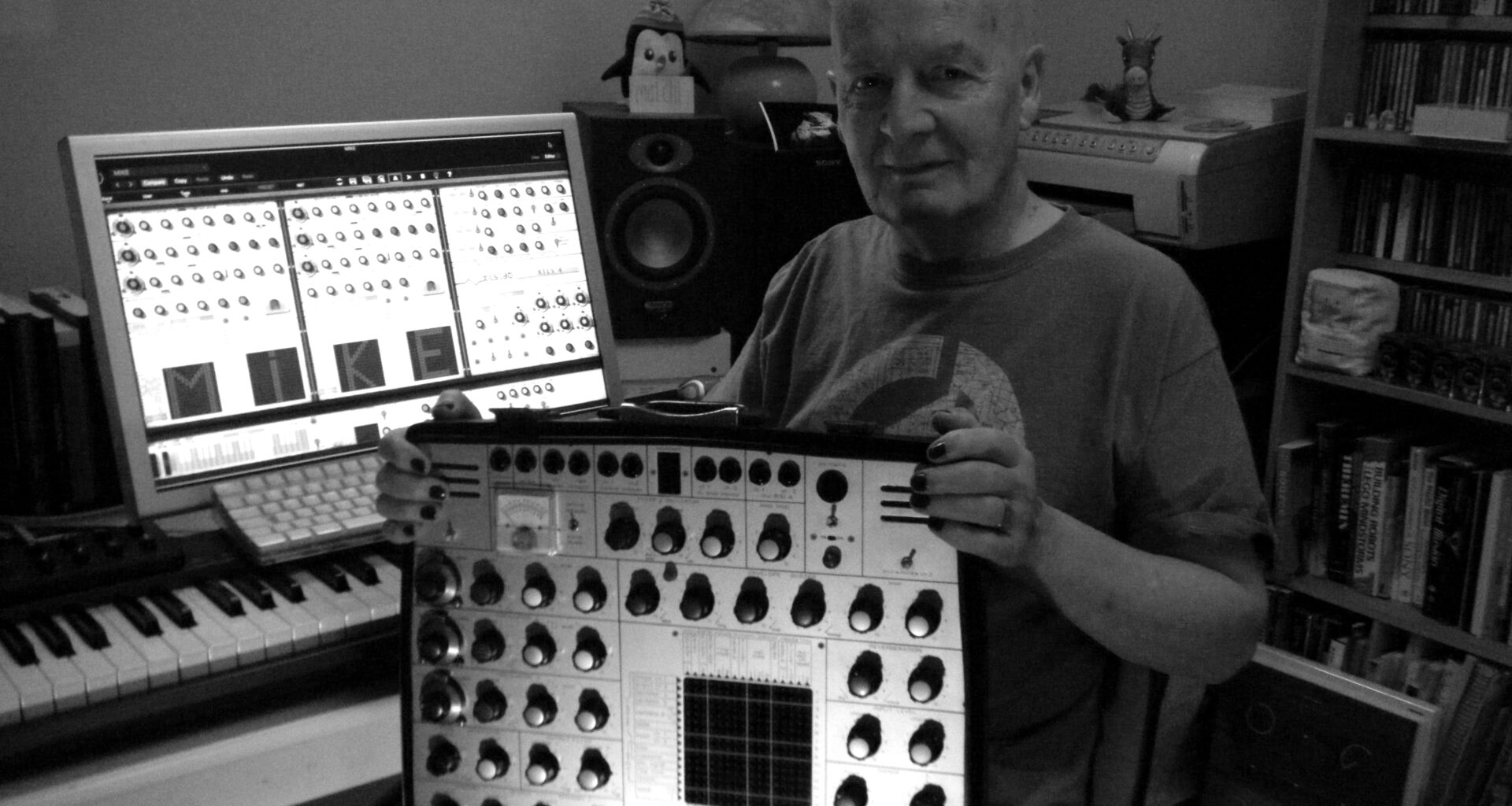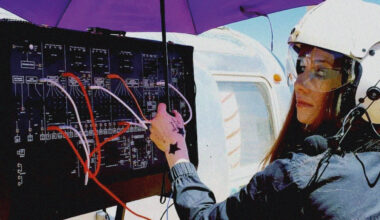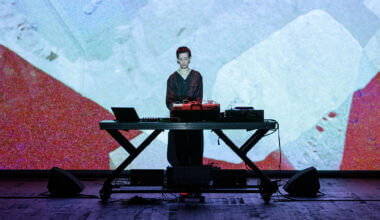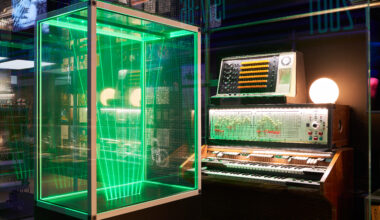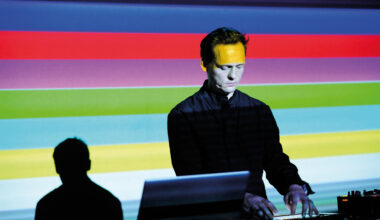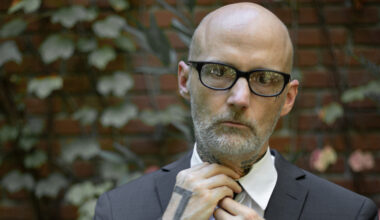From 60s R&B pop fame in Manfred Mann, to The Beatles’ Moog advisor and subversive 70s synth sorcerer, Mike Vickers is the quiet man of British electronic music
One sunny August afternoon in 1969, in the smart leafy London neighbourhood of St John’s Wood, a room in a grand Georgian townhouse reverberated to the strange sounds of a massive Moog synthesiser. The Moog IIIc machine belonged to George Harrison, and the room was a tiny space tucked away in the Abbey Road studio complex. Little larger than a storage cupboard, it was where The Beatles were working together on an album for what they all knew would be the final time. An unassuming chap was helping them with the programming of the fearsome Moog beast – one Mike Vickers.
Vickers had been a founding member of 1960s pop titans Manfred Mann. He’d also made a name for himself as an arranger and, after buying a Moog IIIc modular in 1968, a synth programmer. In fact, he was probably the only Moog synthesiser programmer for hire in the UK at that time.
“It got around that I had a Moog and that I could program it for people,” says Vickers, down the line from his home in Devon. “I learned how to do that from Bob Moog himself, actually. I met him a couple of times, he used to set up sounds, but he refused to touch the keyboard. If he did that, it would bring up all sorts of problems about who was going to get paid for what. So he would set up the sounds and let the band play.”
Which is exactly the role Vickers played for that ‘Abbey Road’ synth session. But how did a quietly spoken member of a particularly sprightly R&B band-turned-swinging 60s pop stars become London’s go-to Moog guy?
A trained woodwind musician, Mike Vickers played guitar in Manfred Mann. Although he wasn’t that interested in the guitar, the band recognised they had a multi-instrumentalist onboard who was capable of putting together orchestrations that swelled their sound considerably.
“I knew how to write for other instruments,” says Vickers, “and occasionally we used extras, like strings, and there were horns on one piece I think.”
These modest orchestrations tended to happen when the rest of Manfred Mann weren’t in the studio. Vickers worked with hired players and the band’s producer John Burgess at the controls. Burgess was a producer at Abbey Road, where the Manfreds recorded for EMI imprint His Master’s Voice, which is how Vickers came to the attention of The Beatles’ producer George Martin.
Vickers’ ambitions had long stretched beyond the pop treadmill he found himself on. Following a string of hits with Manfred Mann, he left the band in late 1965. His first extra-curricular success had come in the same year, a composition called ‘On The Brink’, which was used as the theme tune for the BBC TV programme ‘The Wednesday Play’, and was released as a seven-inch single under his own name. It became a northern soul classic, full of blowsy horns and high-end climaxes via its stomping beat, a pounding piano theme, and strings effected with an intense vibrato. It’s the kind of thing Barry Adamson and David Holmes later plundered for their retro thrills and decent copies sell for around £80 these days.
‘On The Brink’ resulted in Vickers being offered the chance to score a film, a comedy vehicle for Michael Bentine called ‘The Sandwich Man’. Chunks of it are on YouTube if you want to wile away an hour or so in a bizarre time capsule of madcap 60s-ploitation. It was clearly trying to cash in on the new British taste for offbeat humour exemplified by ‘A Hard Day’s Night’ and ‘Help!’.
“I left the band pretty soon after getting the film commission,” says Vickers. “I thought, ‘If I’m going to do this properly, I’m going to need lots of time to do it’.”
More film and TV work followed, as well as sessions arranging pop hits for the likes of Engelbert Humperdinck. Vickers was seen as a safe pair of hands that could be turned to all manner of styles. His versatility, reliability and modesty are almost certainly why he got his first call to work with The Beatles. In 1967, two years before the ‘Abbey Road’ sessions, he spent a week helping with the orchestration of ‘All You Need Is Love’ in the frenetic scramble to get The Beatles ready for their imperial performance on the ‘Our World’ live broadcast.
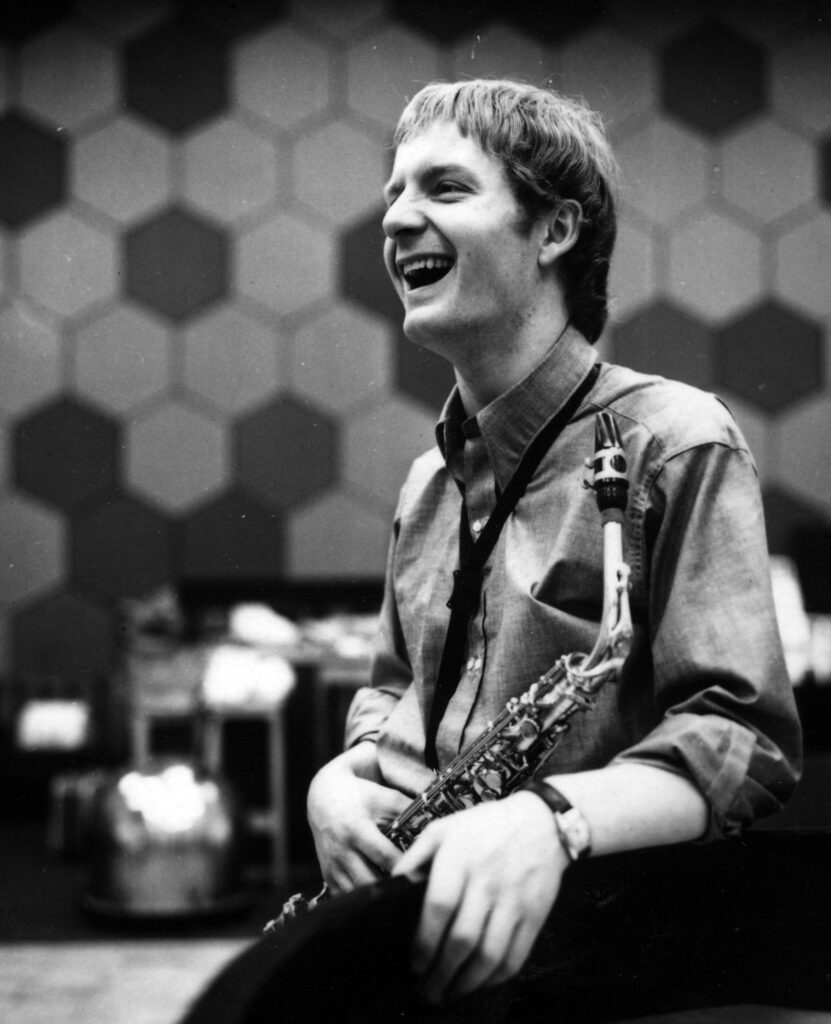
Vickers soon became a well-established part of London’s eclectic recording scene, working with an ever-changing cast of pop stars, session musicians and producers. Meanwhile, over in the US, Dr Robert Moog was gearing up a marketing campaign for his new kit, and had his sights set squarely on those at the heart of the music industry – the musicians and the producers, especially those in swinging London.
It was inevitable the pair would bump into each other sooner rather than later. Sure enough, Vickers was soon privy to studio chatter about Moog and his new wonder instrument. Entranced by the very idea of the Moog, without ever having been near one, Vickers ordered the monstrously pricey IIIc modular from Dr Moog himself in 1968.
“I wanted it without really knowing what I’d do with it,” he says. “I had to wait some weeks for it to arrive, as it was a special order. All I had in the meantime were three double-sided pages with a paragraph about each module. I read through those over and over again, usually at night when I was trying to get to sleep. After about the second week of doing that, I suddenly realised, to my horror, that you could only play one note at a time. I thought, ‘For this amount of money, this is ridiculous!’.”
Undeterred, he remained committed to joining the exclusive Moog owners club, which at that point had just three British members. Moog’s first UK-based customer was George Harrison. As is only right and proper, the Moog that featured on ‘Abbey Road’ was the first Moog synthesiser to arrive in the UK. Then came Mike Vickers’ Moog, and next was one ordered by George Martin for his brand spanking new Hampstead-based AIR Studios, a business venture launched with John Burgess.
A few months before the ‘Abbey Road’ sessions, in May 1969, George Harrison released his solo album ‘Electronic Sound’, made entirely with his expensive new toy. The album was two sides of electronic doodling, some of which featured Bernie Krause, the American recording artist, sound archivist and, alongside his business partner Paul Beaver, Moog evangelist/salesman.
It was Beaver and Krause who had shown the Moog to the American public for the first time from a booth at the Monterey Pop Festival in 1967, and Krause showed Harrison how to get sounds from his purchase.
Indeed, part of the ‘Electronic Sound’ album was Krause demoing the unit to Harrison. Famously, when the record was released with Krause’s name alongside Harrison’s on the front cover, Krause demanded it was removed.
Because Vickers had worked with George Martin many times, and because he’d proved his worth to The Beatles before, the fact he owned a Moog and knew how to use it no doubt led to him being called in to help with the synth parts on ‘Abbey Road’.
“I remember when I walked into the studio,” says Vickers, “I heard ‘Because’ for the first time. It was so beautiful. They were adding voice parts to that.”
Once Vickers showed up, the synth session soon got under way.
“They’d play a track and the composer, whether Paul, John or George, would suggest what sort of sounds they wanted for it. It was orchestral language rather than synthesiser language. So I would set the sounds up, and then one of those three would play the part they wanted on that particular track. It was all very efficient.”
Despite – or perhaps because of – the fact that the band knew The Beatles were finished, the session ran smoothly.
“All this talk of the band falling to pieces – nothing like it!” says Vickers. “They knew exactly what they wanted to do and we did it all in one afternoon. Quite a few bits. It was very calm. Nobody seemed to say anything to anybody else, they all seemed to know what was happening next. It was honestly amazing to see how they worked together. Nobody told anybody to do anything; it just sort of happened. Extraordinary.”
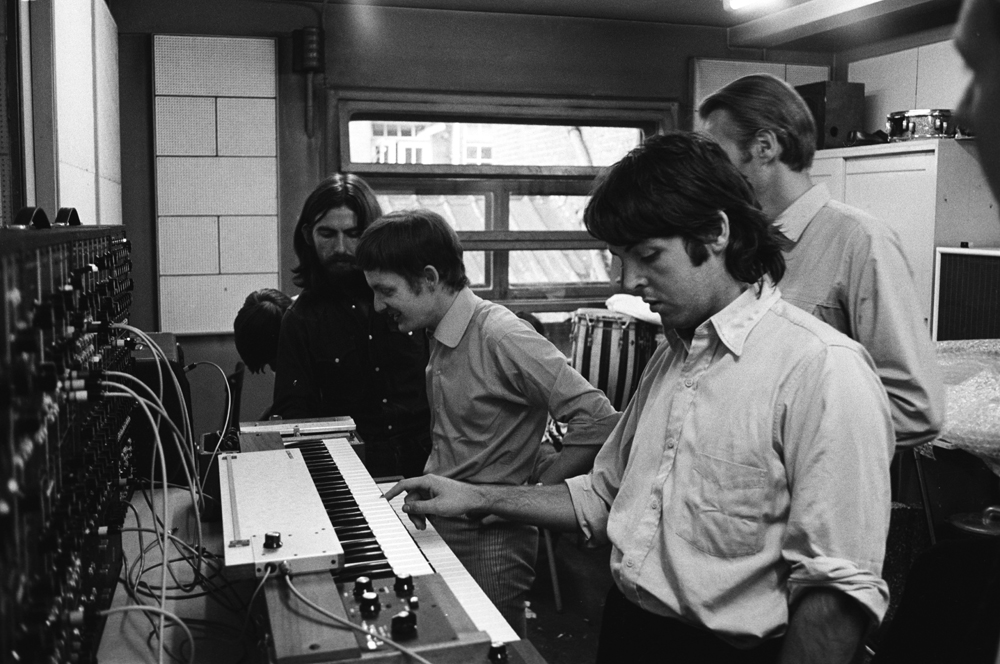
The public first heard the Moog on a Beatles record on ‘Maxwell’s Silver Hammer’, track three on side one of ‘Abbey Road’, which was released on 26 September 1969. Lush synthy tones wash over the intro to the second verse of McCartney’s legendarily unpopular composition (it took weeks to record and Lennon hated it). It provides a gentle tootling countermelody playing throughout the second verse and another slightly more string-like workout behind the scenes on the third verse, which gradually moves across the stereo field and ends with a high-pitched wail, before providing the cheerful little synth solo at the end.
“That machine can do all ranges of sounds – so if you’re a dog, you could hear a lot more,” claimed John Lennon. “It’s like a robot. George can work it a bit, but it would take you all your life to learn the variations on it.”
On ‘I Want You (She’s So Heavy)’, Vickers remembers Harrison manipulating the Moog.
“There was a module on the Moog called the fixed filter bank. If you shoved something through it, you could change up to 16 frequency bands, so each one selects a narrow band. He was sort of randomly turning up these knobs on the fixed filter bank.”
That same afternoon, Vickers helped The Beatles lay down the other Moog parts: the fat pulse width tones on the “Sun, sun, sun, here it comes” part on “Here Comes The Sun”, and the subtle brassy fanfare and delicate little synthy tune on ‘Because’.
Unsurprisingly, despite not getting a credit on ‘Abbey Road’, Vickers’ name got around as the Moog Guy. One day, he had a phone call from Robin Phillips, who ran the music library service KPM, asking him if he’d like to record a Moog album for them.
KPM had been around since 1959, when it started putting out 10-inch records of orchestral tunes intended for use on TV programmes whose budgets didn’t stretch to commissioning their own theme tunes and incidental music. The BBC had the Radiophonic Workshop to create bespoke electronic tunes, atmospheres and idents for their programmes, and everyone else had KPM discs. Compositions by the likes of Alan Hawkshaw and Keith Mansfield became well-known TV themes – shows such as ‘Captain Pugwash’, ‘The Dave Allen Show’, ‘Animal Magic’, ‘The Big Match’, ‘Grandstand’ and ‘Grange Hill’ all used KPM pieces. Composers received an upfront fee, and then shared royalty payments with KPM on any of their work that was picked up and used. It could be quite lucrative for the jobbing composer. And in the early 1970s, new electronic sounds were in high demand.
In 1972, KPM released a flurry of electronic library records. Ron Geesin, who was responsible for the orchestrations for Pink Floyd’s ‘Atom Heart Mother’ in 1970, made one called ‘Electrosound’. There was also ‘Electromusic’ by Eric Peters and ‘Electrosonic’ by a mysterious trio known as Harper, Russe and St George, which was, in fact, Don Harper, Brian Hodgson and Delia Derbyshire, the latter two moonlighting from the Radiophonic Workshop. Hodgson and Derbyshire, together with David Vorhaus, had also recorded ‘Electronic Music’ for rival library music outfit Standard in 1969, the same year they put out the pioneering ‘An Electric Storm’ album as White Noise.
The KPM releases all came in a standard green sleeve with the track titles and one-line descriptions for each piece, designed to make the harassed TV producer’s job easier.
“KPM just said they’d like a library album from me using a synthesiser, really,” says Vickers. “From then on, they gave me free rein. That was what tended to happen with library music.”
With the painful punning that seems to have been de rigeur for Moog records of the era, Vickers’ album was called ‘A Moog For All Reasons’. It was a combination of tunes that used the iconic synth as a melodic lead instrument, with drums and bass guitar providing the backing, like on the jaunty ‘Mr Milkman’ and ‘Electric Apple’. Often these compositions would be interspersed with pure electronic experimentation, like on the mechanically frenetic edginess of ‘The Adding Machine’, the bouncing strangeness of ‘Elastic Band’, the detuned ‘Crisis’, which builds into a fearsome wash of electronic noise, or the scientific squealing of ‘Microbe’, a slice of pure Radiophonic-style electronic atmosphere to inspire dread in the average listener.
All these tracks show off the Moog IIIc’s fat sound and sequencer precision as well as the sonic experimentation Vickers was capable of when allowing himself to indulge his electronic explorations.
“I did some of the most adventurous stuff I’ve ever done for that library,” says Vickers. “At the same time, I did some of the most cheesy stuff. I was inspired to go as far out as I could with the Moog, though one part of me wanted to keep it real in that old sense of what I used to do.”
The titles usually give plenty of warning of impending cheese – ‘Pigtails’, ‘Lollipop Shop’ and ‘Baby Bouncer’ from Vickers’ 1975 follow-up KPM release, ‘A Moog For More Reasons’, for example. Then again, the likes of ‘Breakthrough’, ‘Getaway Car’ and ‘Limit Of Endurance’ are tense Moog workouts revelling in the sound of the machine itself, creating a tension worthy of John Carpenter.
The KPM albums were all made by composers and high-end session players who were far removed from ideas of what was hip or not. They weren’t trying to create cool records or establish a pop reputation. They were professionals creating music intended to perform a specific job. This down-to-earth approach is what made them essential contributors to the sonic backdrop of the era. As such, they’ve become sought after collectors items. A mint copy of ‘A Moog For All Reasons’ will set you back around £50, if you can find one.
“God knows where they are getting the stuff from,” says Vickers of this collector’s market. “They must all be scratchy old albums they’re playing. Awful! It’s out of my control, of course.”
Now aged 78, Vickers has rediscovered a love of pure electronic music and is pursuing it with a purist’s fervour.
“I want to go back to electronic music and do it properly,” he enthuses. “Not be available for hire, not do tunes, not be poppy and middle of the road, but to avoid routine things, avoid generic bass and drums, and choruses and verses and tunes. I want to just treat it as something to explore, as a new thing.”
He has amassed hours of new electronic compositions and is in the process of editing them into something he feels worthy of releasing. He’s also hoping to play some gigs.
“I suppose I am some sort of voice from that time,” he says with typical lack of vanity. “I’m from that era when electronic music was new, but now I’m doing it again, I’m speaking up for electronic music for itself – pure electronic music.”
For more about Mike Vickers, see mikevickers.net
